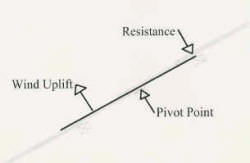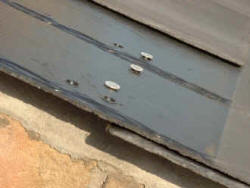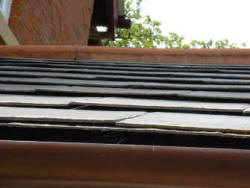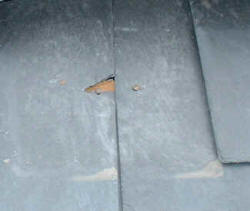| Natural slates by their very nature are simple
thin slabs or rock held onto the roof with two nails. What could be
simpler than that? But for the system to work the slates need to be rigid
in their length and width, and the nail fixings need to perform their
function of holding the slate tightly to the roof structure. The best
technique is to use centre nailing. But this alone is not without its
problems. |
|
Centre Nailing |
| The centre nailing of double lap natural or resin slates is a very
efficient method of securing slates to a roof structure. With the upper
part of the slate resting on one batten and the middle of the slate nailed
through into another slate, wind suction on the lower exposed section of
slate tries to rotate upwards about the centre nail fixings. The upward
lift of the lower half of the slate forces the upper part of the slate
onto the top batten. |

|
| As the uplift force
of the lower exposed section of the slate increases, the inability to rotate
about the nail fixings forces the slate to try and rotate about the top edge
of the slate. |
| To do this the slate needs to pull the centre
nails out of the lower batten. The further the nail fixings are away from
the top of the slate, the greater will be the lever arm effect of the
fixings. A typical twice nailed 30x3.0mm copper nail fixing with 500x250mm
slates can by calculation be expected to resist the anticipated wind
forces for all but the most exposed roofs in the UK. |
|
Raised Nail Fixings |
| The correct way of nailing a slate into position is to drive the nail
fully down into the timber batten, such that the head of the nail is
located in the spalled cup of the nail hole, or is in contact with the
surface of the slate. Most slaters will drive the nail down to within
0.5mm of the surface of the slate for fear of hitting the slate and
breaking it. This will allow the leading edge of the slate to lift up to
about 1mm. |
 |
| The
greater the distance between the underside of the nail head and the top of
the slate, the more the leading edge of the slate can be lifted by the wind.
The more the leading edge can be lifted the greater the risk of the wind
causing the slates to rattle, making a lot of noise. |
| Also as the wind lifts a slate it can stop with
a jolt, placing a greater stress on the slate at the nail hole position,
causing the slate to snap between the nail hole fixings. |
|
Resin Slate Camber |
| Nail heads with more than 2mm below them will also hold the next slate
up clear of the slate below. The larger the nail gap the greater the gaps
between the slates will be. With Natural slates the gapping will not only
allow wind driven rain to enter the head-lap, but will also result in
breakage of the slate if walked on as the nail heads act as point supports
for the load, increasing the stress. With resin slates raised nail gapping
will increase during the first five years as the material relaxes. |
 |
| Resin slates begin
life with a slight camber in their length. Whilst being nailed the slate
must be pushed down onto the lower slate and the nails driven fully home. |
| If this is not done a gap will be left between the slates.
With time the memory in the material causes it to relax back into a flat
sheet. The material will continue to relax until it rests on the lower
slate and the raised nail heads of the course below. This can result in
the slate developing a camber in the opposite direction, causing the
leading edge to lift more excessively. |
|
Batten Bounce |
| The reason for the existence of raised nails
may be craftsman's error, but it may not be! It may be that it is
impossible to drive the nail into the batten any further. Springy battens
can allow batten bounce to occur. This is when a batten acts like a leaf
spring. It is most common at the mid span position of rafters at 600mm centres,
close to a verge or side abutment and with sub-standard battens. The
impact load of the hammer hitting the nail head should force the nail into
the timber batten, but some of the force will also cause the batten to
deflect. The larger the nail diameter and the greater the nail penetration
into the batten, the more force that is needed to drive it in. There comes
a point where the force needed to drive the nail into the batten is more
than to deflect the batten or bend the nail. At this point it is
impossible to drive the nail in any further. The consequences of batten
bounce are that at maximum penetration the nail may be 3-4mm above the
slate, but under maximum impact the batten may deflect more than 3-4mm.
The slate being flat and rigid will not follow the curve of the batten and
will span across the curve. When the gap below the nail hole becomes more
than 3-4mm the nail head will come into contact with the slate and stress
the slate at that point, resulting in breakage. In this situation it may
be better to remove the nail and screw the slate into position, as a screw
will pull the batten up with no deflection. |
| Expansion and contraction, or wetting and
drying, of the timber do not cause raised nails. Research has found that
the only way a nail will come out of timber is with a tensile load, i.e.
it is pulled out by a greater force than the grip resistance of the nail
in the timber. If nails did work their way out due to thermal or moisture
effects, we would have an epidemic of loose tile and slate battens, which
is just not reality. |
|
Nail Holes |
| The position of the nail hole relative to the
edge of the slate is critical. The closer the nail hole is to the edge of
the slate the greater the risk of having a badly formed nail hole or
breakage of the edge of the slate. The nail hole should not be any closer
than 20mm in from the edge of the slate and not so far in that it comes
within the area of the slate potentially affected by water penetration.
The actual maximum distance in from the edge will vary with slate width,
head-lap and rafter pitch (further guidance is given in BS5534) |
| The size of the nail hole can sometimes be too large for the
head of the nail, with only a small part of the nail head coming into
contact with the surface of the slate, thereby reducing its effectiveness
in transferring the wind uplift load into the batten. Wherever possible
the nail hole should be slightly larger (1mm) than the diameter of the
nail and be punched from the rear to leave a slight dish on the face to
allow the nail head to sit into the slate. If the first nail hole is
defective there may be room for a second nail hole along the batten line
before it falls too close to the edge or the potential area affected by
water penetration close to the centre of the slate. |
 |
|
Re-fixing slates with nails or screws
can only be achieved if a patch of slates is removed or re-slating back up
to the ridge is undertaken. |
|
Conclusion |
| Nails are a very simple and effective method of
securing slates to a roof, but they must be installed correctly, both in
terms of the head being in close proximity to the slate, and the slate
being in close proximity to the batten. The slate needs to be rigid,
strong and have clean nail holes punched in the correct location for the
fixings. What could be simpler? |